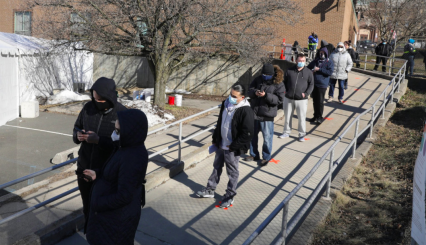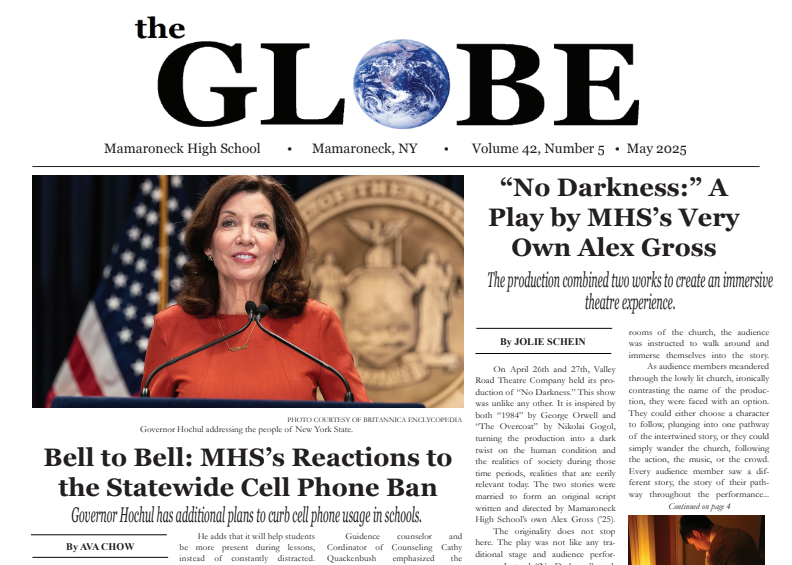Teachers Reveal Struggles of COVID-19 Vaccine Distribution

Photo Courtesy of Lohud on Facebook
Westchester residents wait on line to receive a vaccine at Yonkers distribution site.
March 15, 2021
Since society’s shutdown in March of 2020, promises of a COVID-19 vaccine have mounted a hope for one day going back to the ‘normal’ way of life. Now, with three vaccines being approved by the Food and Drug Administration (FDA), vaccine rollout and distribution has begun its rapid ascent. The allocation of the vaccine has gone on to Phase 1B in New York State, and it is being administered to frontline essential workers, such as the teachers of Mamaroneck High School. As more educators receive the vaccine, various struggles become evident, ranging from the decision to take the shot, to the actual vaccination itself.
A multitude of factors weigh in on the ultimate decision of registering to receive the vaccine. Sure, one may do a bit of research on the process and vaccine, but even that results in certain issues in itself. There is so much differing information out there that, for some, it culminates in a sense of confusion or fear towards the vaccine. To add on to this abundance of varying information, several people have had severe allergic reactions, such as anaphylaxis, a life-threatening reaction involving a skin rash, nausea, vomiting, difficulty breathing, and shock that could result in unconsciousness or death. This possibility of death upon taking the vaccine further fuels the fear against it, discouraging some from taking it. The unknown risks, due in part to its novelty, are also a source of uncertainty, especially for those who aren’t knowledgeable on the topic and for those that already don’t trust vaccines.
All of this is worsened by the political atmosphere that seems to be surrounding the vaccine. Those that don’t trust the government are more hesitant to receive it. Previously, a Trump endorsement of the vaccine dampened the likelihood that individuals would vaccinate. However, statistics by The Brookings Institution, a nonprofit public policy organization, depict that a current endorsement by Biden fares no better statistically, only bringing a three percent willingness increase. The rush of the vaccine, and the fact that it was brought to market under an FDA Emergency Use Authorization also leads people to perceive this process as politicized and unsafe. These conditions foster the idea that there may not be full transparency when it comes to the vaccine, which can be considerably unnerving.
Nonetheless, numerous teachers have received the vaccine or are currently scheduled to receive it. A common struggle lies in the process of getting an appointment. To get an appointment, one goes to a website where one enters information and the site decides whether or not one is eligible to receive the vaccine. Afterwards, it takes you to a site to find and set up an appointment. Therein lies the struggle. English teacher Ms. Ramirez was among the numerous teachers who “found the website to not be user-friendly” and the amount of required refreshing done on the page was frustrating. Aside from this, the appointments themselves were extremely scarce. Not only were teachers slightly panicked about the sign-up prior to becoming eligible, but the frantic search to book an appointment seemed to be a common experience.
When teachers first became eligible to receive the vaccine in early January, some signed up to get vaccinated at locations such as the Bronx. When the County Center in White Plains was open for registration not long after on the NYS Covid-19 vaccine site, appointment availability rapidly diminished. Some teachers had signed up prior to the start of the school day that Monday, and others, such as Math teacher Ms. Rinaldi, discovered that “by second period, I was already looking at the end of January for my appointment.” In some instances, the search for an appointment spanned numerous days and when one was discovered, it would be the only one within months. However, the nerve-racking experience did not end there as appointments at certain sites had to be cancelled due to a shortage of doses of the vaccine. Teachers like Mr. Garbarino were left hoping that there would be enough doses by the time their appointments came.
The teachers whose appointments were not cancelled found that getting the first dose was a highly-orchestrated process. Beginning at the entrance of the Westchester County Center, National guardsmen were stationed outside ensuring the safety of the vaccination site. Then, prior to going in, teachers were questioned about quarantines and COVID-19 symptoms, among other things. They then headed to a registration table to then wait on a socially-distanced line. Along said line, there were people stationed to bring them around until they could enter the room in which they would be administered the vaccine. When they finally entered the room, the vaccination process was also very organized. A doctor would be overseeing the person administering the vaccine, ensuring all went well. Despite the hysteria and difficulty of getting an appointment, as well as the anxiety felt when first arriving at the appointment, teachers found some relief and comfort in the fact that there was a process and felt that it was organized.
Concerns over the administration of the vaccine were also prevalent. Teachers felt a sense of guilt over getting it prior to their parents or loved ones that had seniority and were more susceptible and thus in greater need of the vaccine. One educator, Ms. Garcia, said, “It felt wrong that I could get it but my parents couldn’t.” There were no age parameters within the phases, meaning that younger, healthier people could get it prior to older people in the same eligibility group. The system of distribution itself is seen by many to be faulty.
The COVID-19 vaccine has brought hope to teachers and faculty within the district. However, many teachers believe its distribution was far from ideal. As the pandemic rages on, we can only hope that this process improves.





